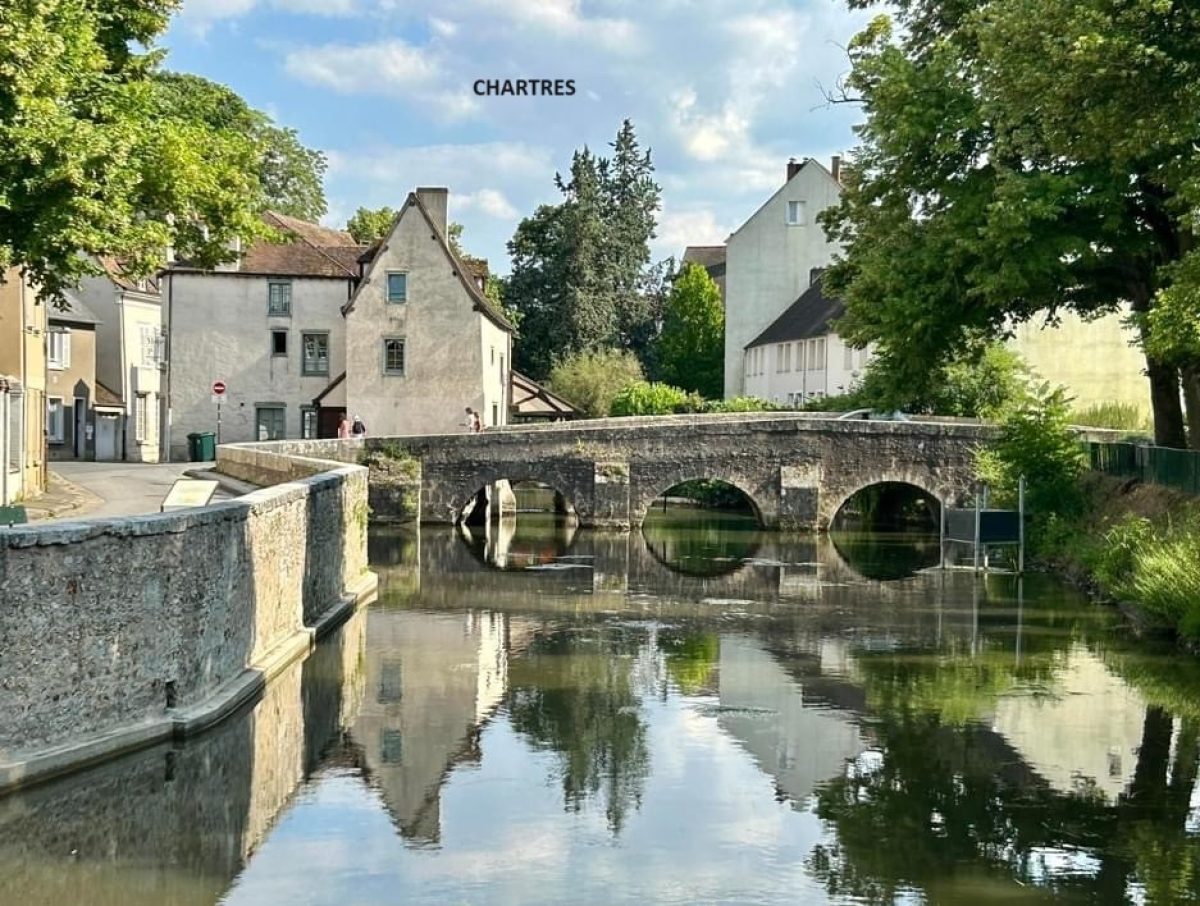The hot weather which troubled the dogs was expected to return to the coastal areas and so we decided to move inland, south to Salamanca. Salamanca is more than 900 metres above sea level and we expected it to be cooler.
The drive through the Cantabrian mountains and the beautiful Las Ubinas La Mesa Park was pleasant. The motorway was quiet and easy and the views were great.

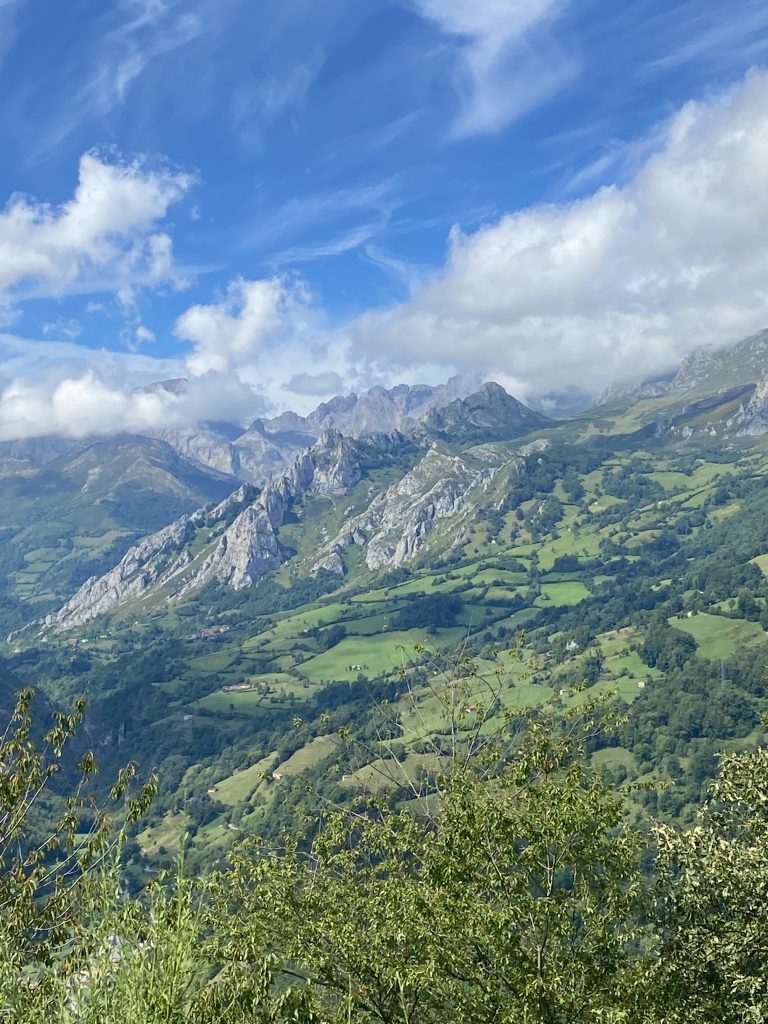
We were keen to see Salamanca at night and so, shortly after checking in at Camping Don Quijote on the outskirts of Salamanca, we drove our Van the 7 kms or so into the city and parked up near the Roman Bridge on the edge of the old town. This lengthy wholly pedestianised bridge is estimated to have been built in the 1st century AD but I suspect little of the original bridge remains.
The entire old town of Salamanca (often referred to as La Dorado, the Golden City, because of the tone created by the setting sun on it’s yellow sandstone buildings) was declared a UNESCO World Heritage Site in 1988 and it is recognised as one of the oldest and best preserved cities in Spain.
My reaction after crossing the River Tormes and entering the old town by the Roman Bridge was one of increasing excitement. Few cities have had such an immediate effect on me. The old town is a compact forest of spires and none are more impressive than those of the two cathedrals. Yes, there are two cathedrals in Salamanca; an Old Cathedral which was put together between the 12th and 14th centuries and a New Cathedral which was built alongside the original cathedral between the 16th and 18th centuries. Believe it or not there are actually 6 cities in Spain with two cathedrals.
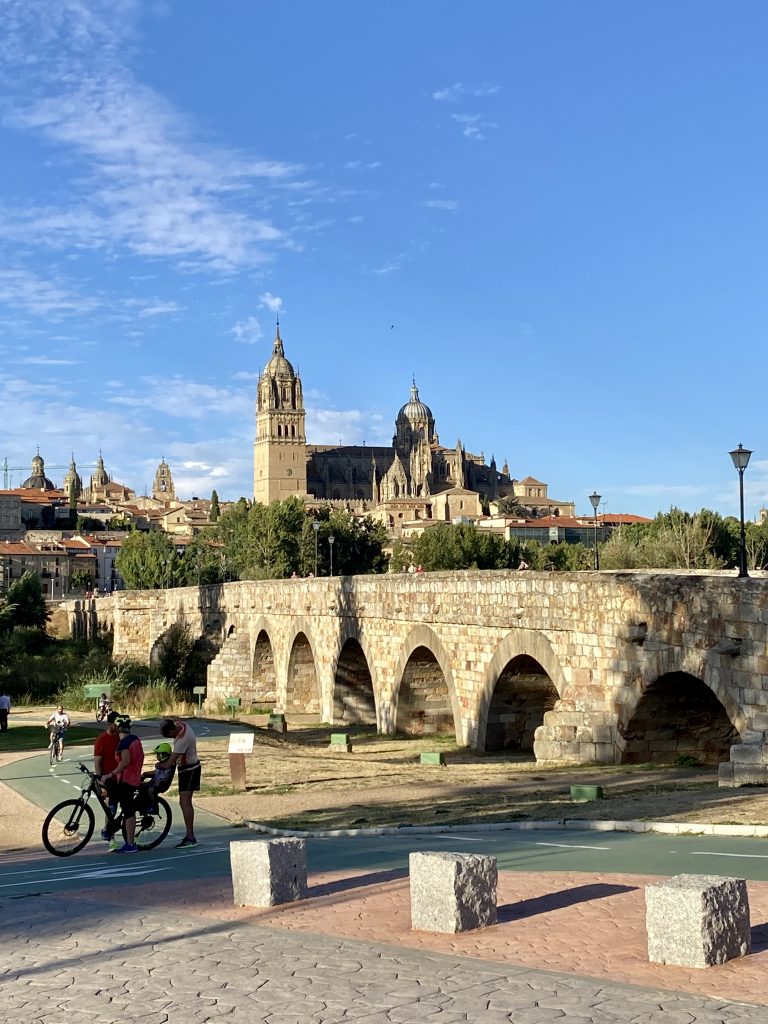
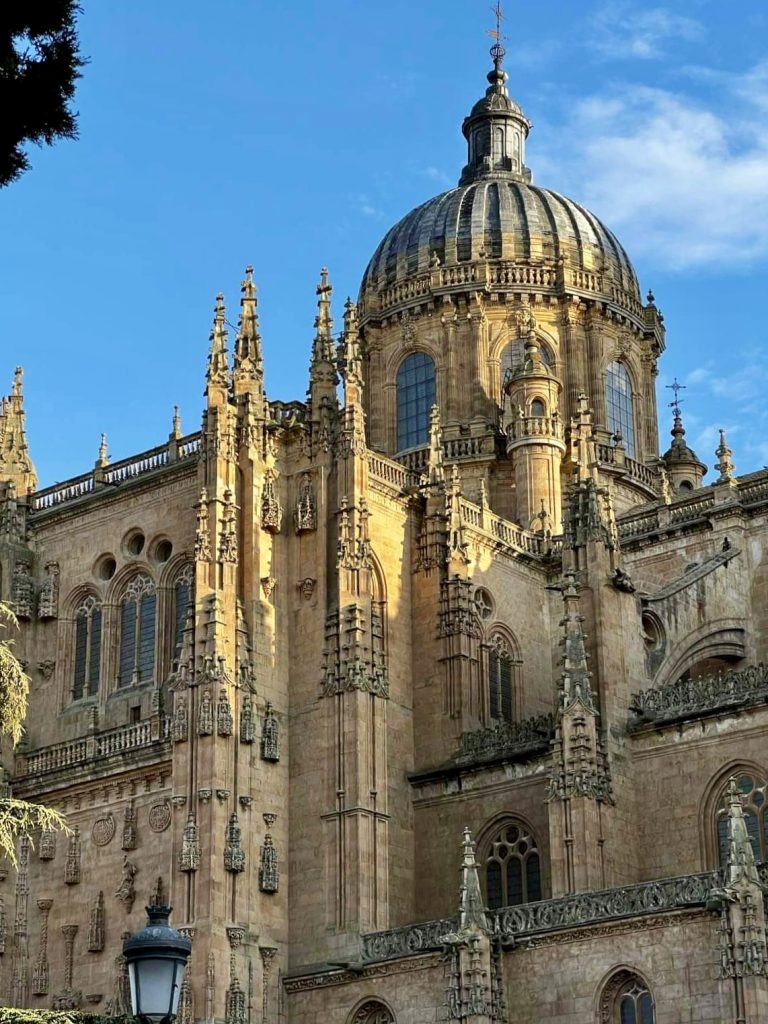
Vanya has never been into churches (I mean that both figuratively and literally) and she waited outside the entrance with the dogs on the Plaza de Ayana while I had a quick look. I didn’t stay long; it would have been unfair to leave everyone waiting outside for the time it would take me to properly view the cathedrals but, I promised to return the next day for a better look.
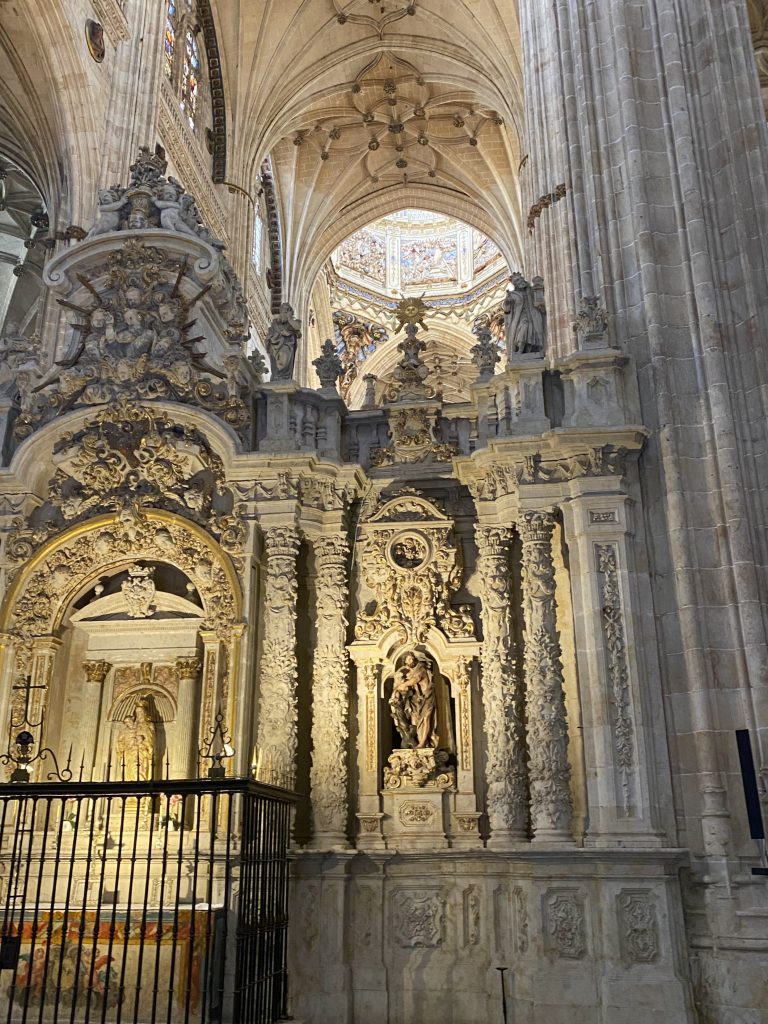
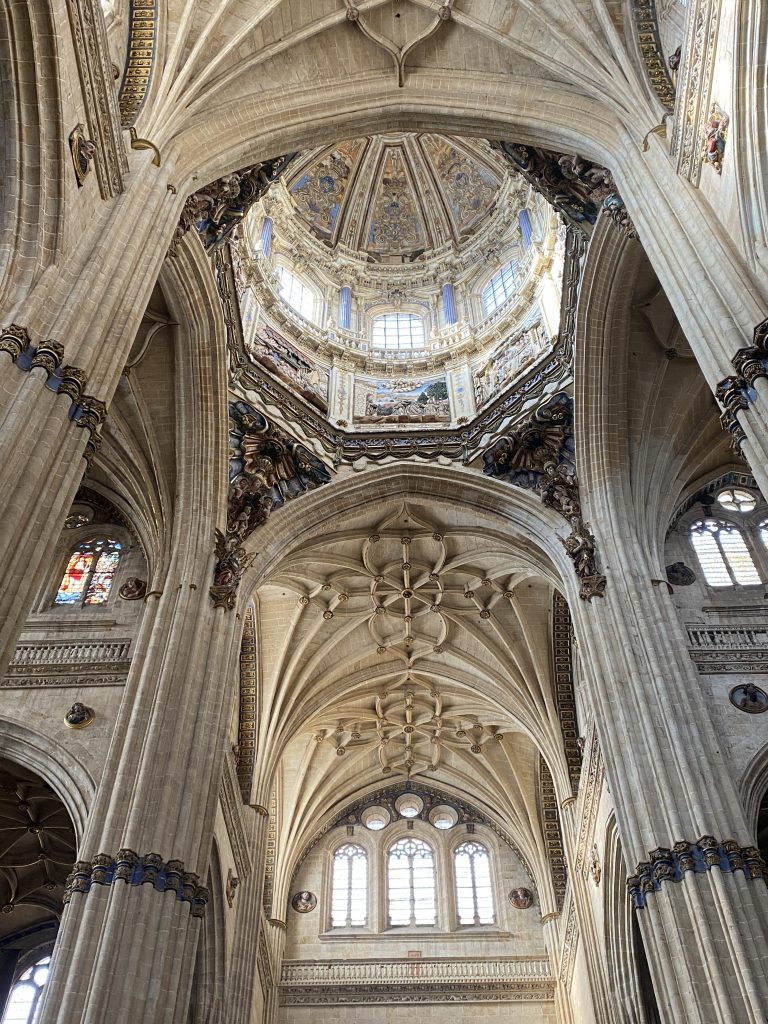
We were particularly keen to see the main square (Plaza Mayor) at night and the evening was closing in on us but we took time to eat at a small tapas bar on Calle Rua Major; which street almost connects the cathedrals with Plaza Mayor.
Plaza Mayor is to most visitors the main attraction in Salamanca, especially when seen at night. It is spectacular at any time of the day with all it’s baroque buildings and porticos but, when lit up it is truly stunning. Photos simply don’t do the place justice; you have to see it.
In case you are interested, there are 88 porticos on the square (although it is actually more of a rectangle than a square) and what sets the porticos apart from those on squares in other large cities in Spain are the stone medallions set at the top of each one. They commemorate famous people who have in some way, shape or form helped benefit Salamanca. There are very few foreigners among them but two that stand out are Christopher Columbus (he who opened up the Americas on behalf of Spain) and our very own Arthur Wellesley, 1st Duke of Wellington who defeated Napoleon’s army under Marmont at the 1812 Battle of Salamanca.
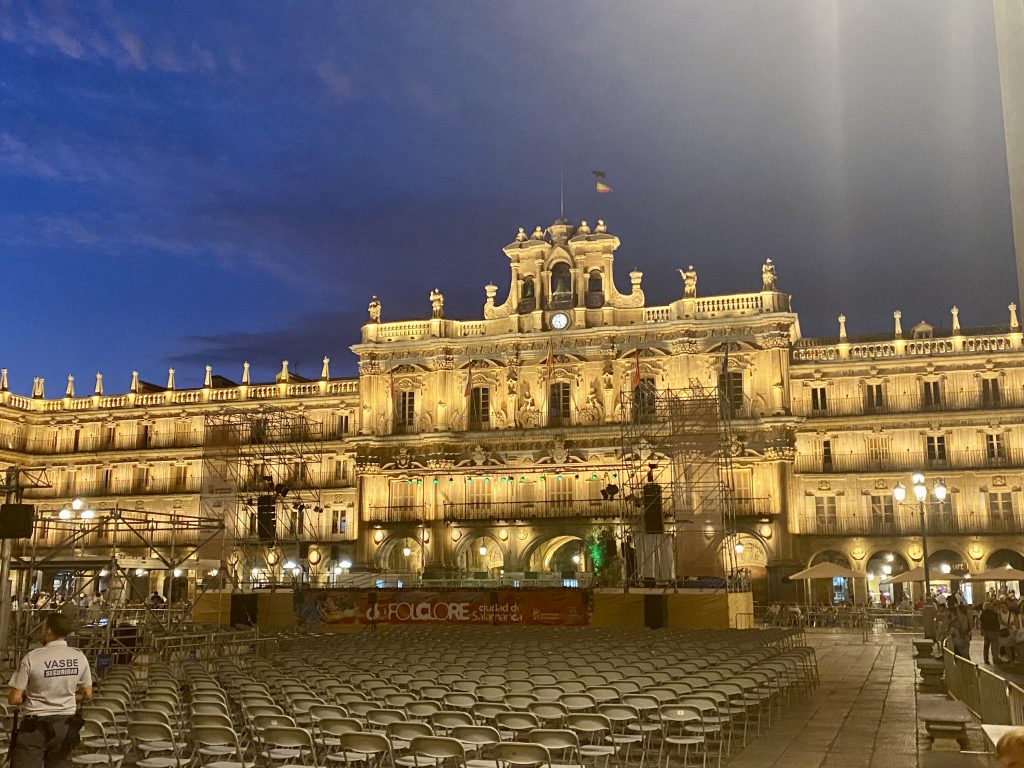

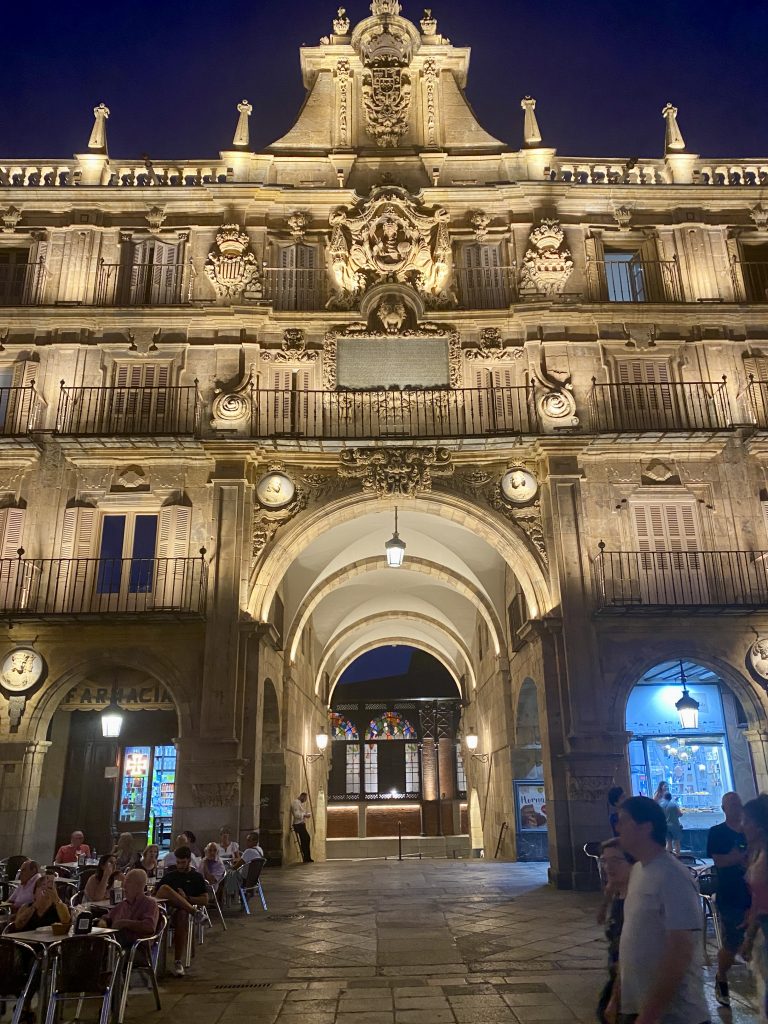
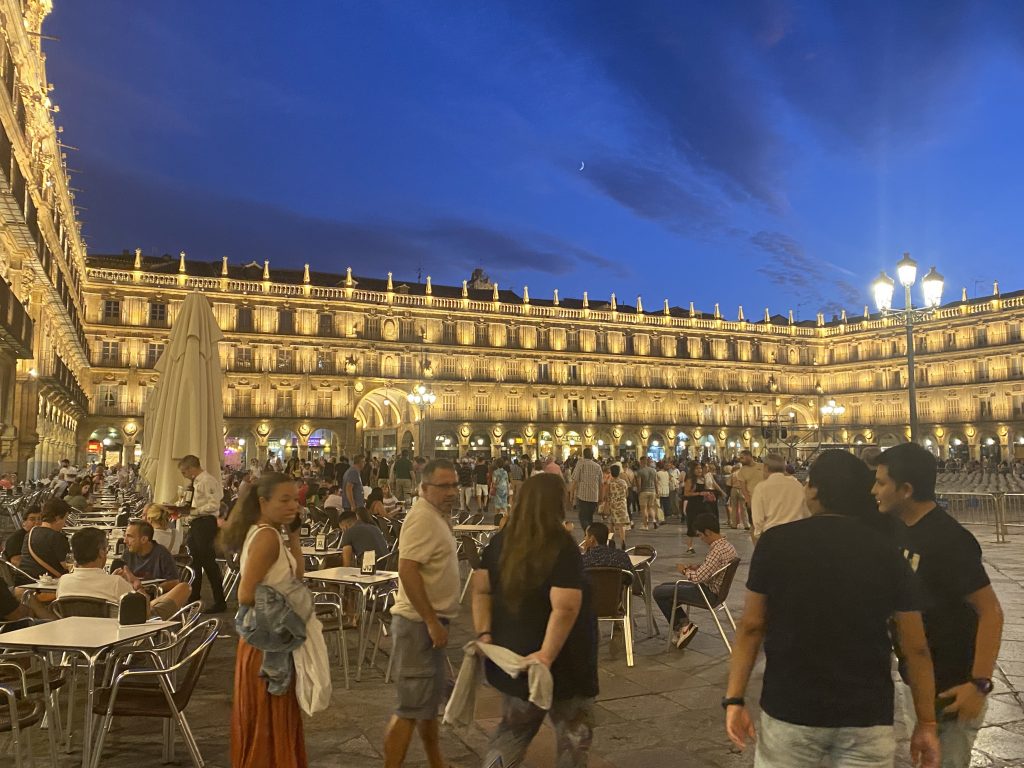
Salamanca is one of Spain’s best cities for decent pinchos (pinchos not tapas because this is still Castilla y Leon) and the Plaza Mayor is an okay (albeit quite expensive) place to enjoy pinchos but; the better, more traditional scene is on Calle Van Dyck just outside the city centre. It will have to be good there to compare with Logrono but we will not find out until our next visit to Salamanca because we were already booked into a supposedly very good restaurant at the campsite for the next evening.
After savouring the mood in the Plaza Mayor for a short while we started back through the old town to our Van; both of us having very much enjoyed our brief excursion into the city. There’s no doubt Salamanca is very pretty and literally stuffed with interesting buildings but the one which most caught our attention on the way back was the Casa Lis. It was built early in the 20th century as a home for a certain Miguel Lis. I cannot tell you anything about him except that his taste was clearly ahead of his time and he was a great fan of stained glass. It is now an art-deco museum and well worth a visit if only to see inside. I love the house and I’m already thinking that two days and nights in Salamanca is insufficient.
Tucked just behind the Casa Lis is the ‘Cave of Salamanca’ which is actually the former crypt of the church of San Cebrian. This church was demolished some time in the 14th century. Legend has it that the devil subsequently taught black magic in this cave. Indeed, in many parts of South America, Salamanca has long been associated with black magic and witchcraft and it may be this legend that gave rise to that belief.

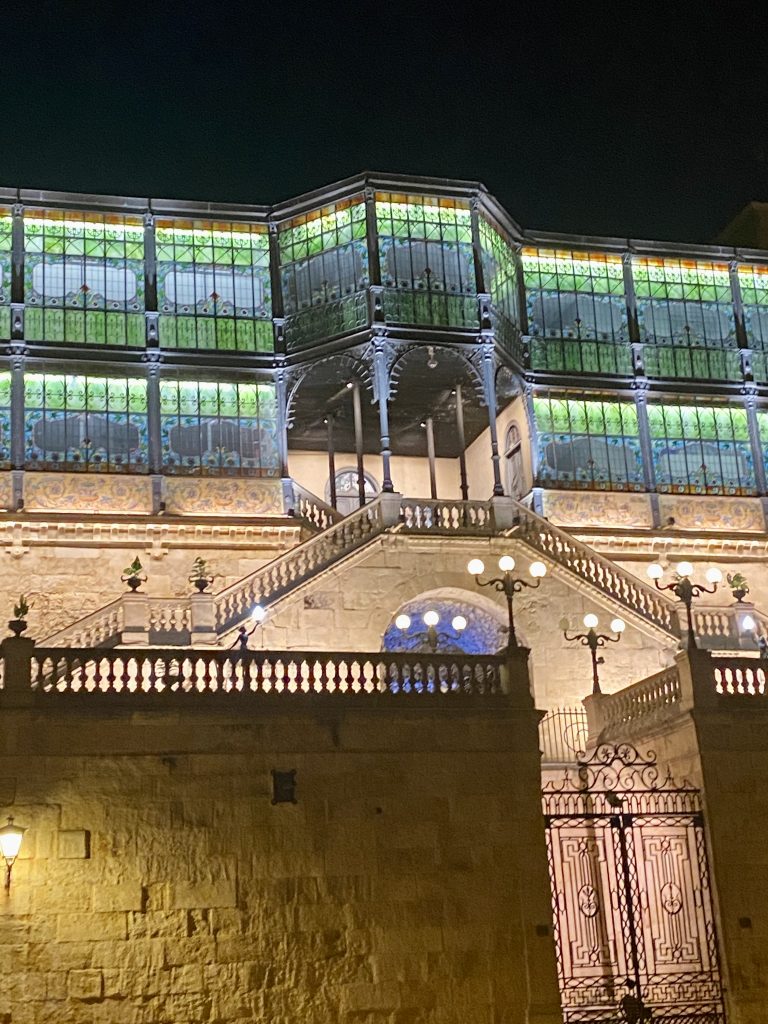
I returned to Salamanca the next day on a local bus – just 1.40 euros for a 20 minute journey to the northern end of Calle Gran Via. Cheap or what!?!
I came primarily to visit the city’s cathedrals but began with a circuitous walk around the city’s old town, marvelling at so many buildings as I did so. Whether they be public buildings like the Convent of San Esteban (a Dominican Church and Convent) or private mansions such as some of those pictured in this blog, they all look magnificent. Moreover, there are plenty of them to see and in such a small area.
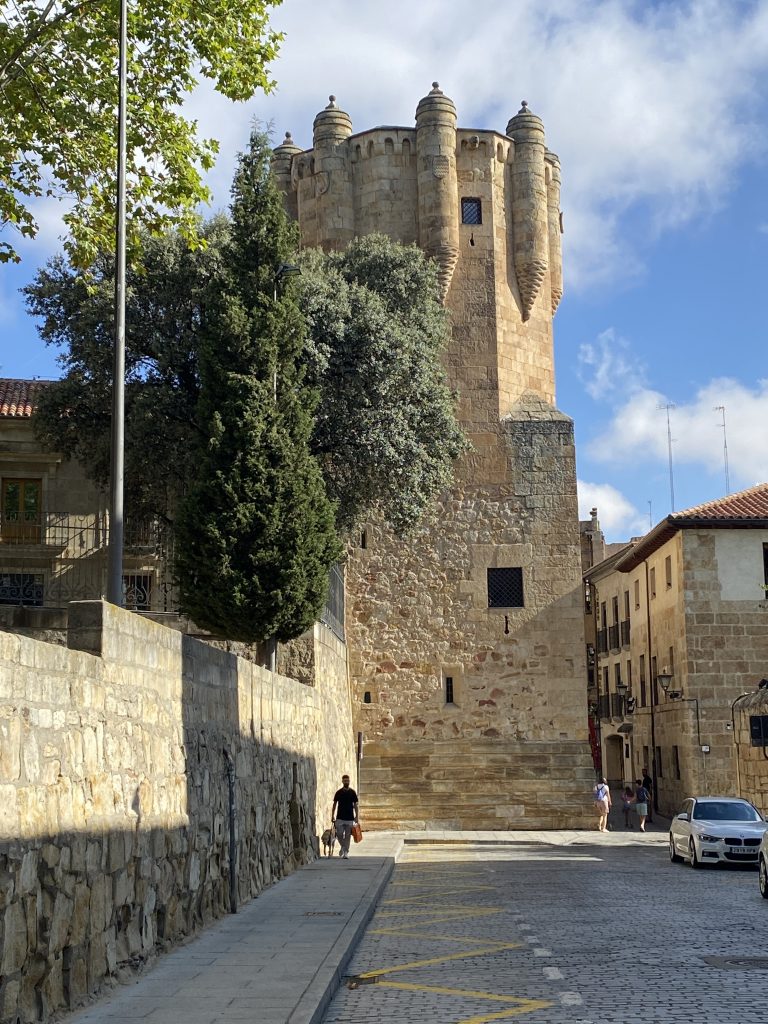

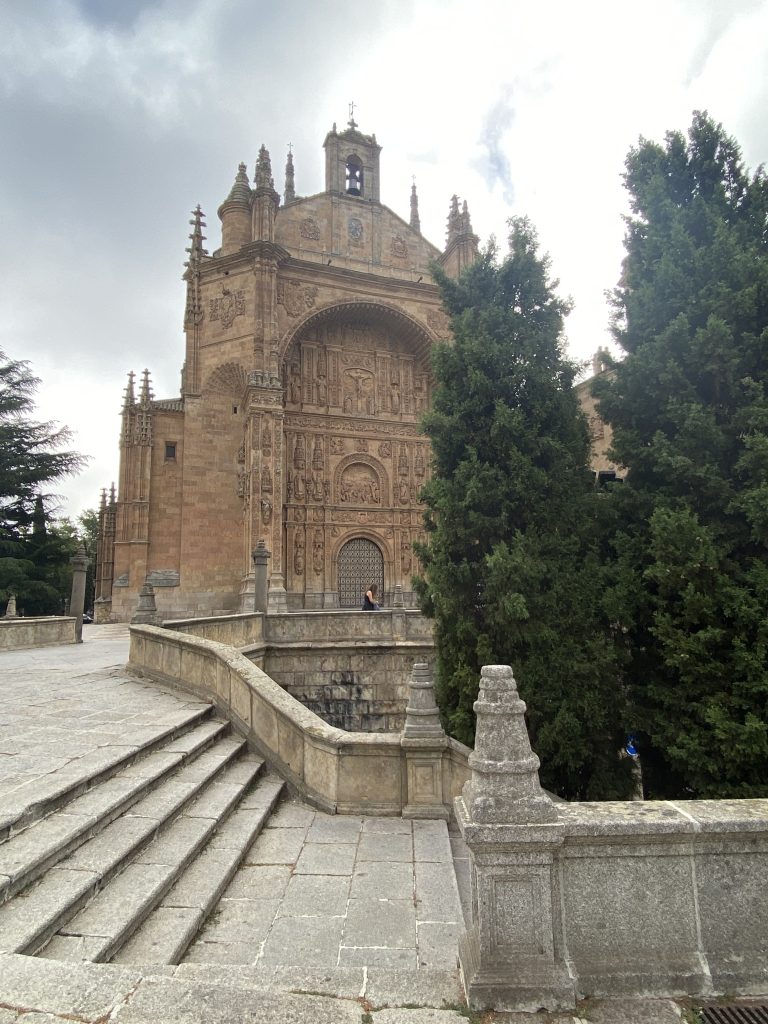
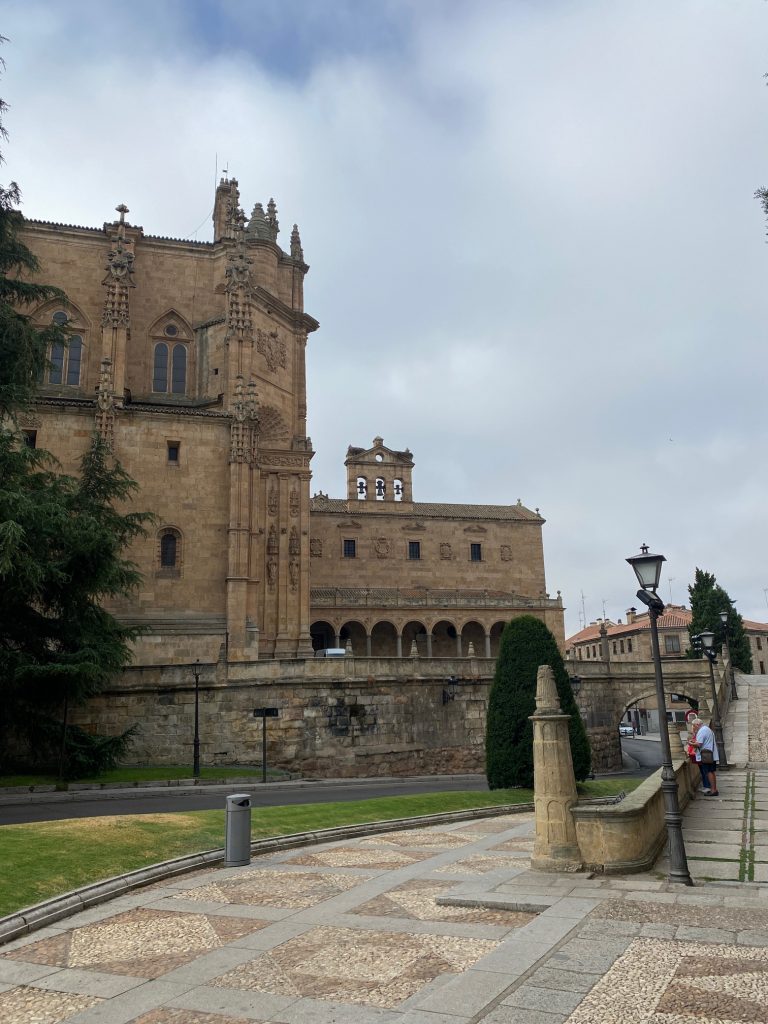
And so to the cathedrals. I wandered inside the pair of them for almost two hours using an English Audio Guide and was enthralled by what I saw and heard.
Before entering the cathedrals, however, it is worth taking time to admire the front entrance. There are a couple of interesting features to be seen which are believed to be the work of the stonemason Miguel Romero. When restoring the front entrance in 1992 it is said he decided to follow a tradition which required that any restorations should include an element referring to the time or year of their improvement. He therefore made two additions being an astronaut and a dragon eating an ice cream. I wonder how many of these I have missed in the past. They’re not easy to spot.

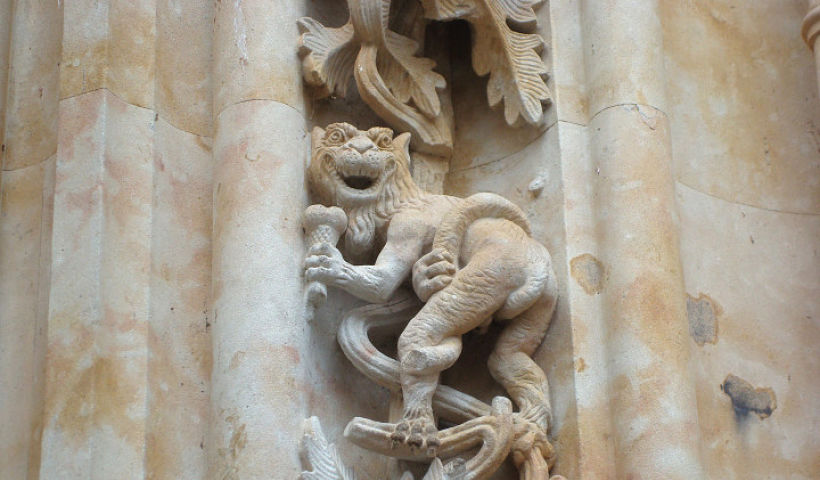
Inside the New Cathedral there are three naves. Those to the left and right of the centre nave contain numerous chaples, each of which is explained in the Audio Guide. The ones that stood out for me include the Sepulcros de La Puerta de Ramos, the Capilla de la Soledad and the Capilla del Santo Cristo de las Batallas. The Guide also explained the intricately carved Choir Area in some considerable detail (the Choir Area sits in the central nave) but it is the cathedral’s long thin pillars and ceilings that most impress. The pillars, vaulted ceilings and 80 metres high dome are simply unbelievable.
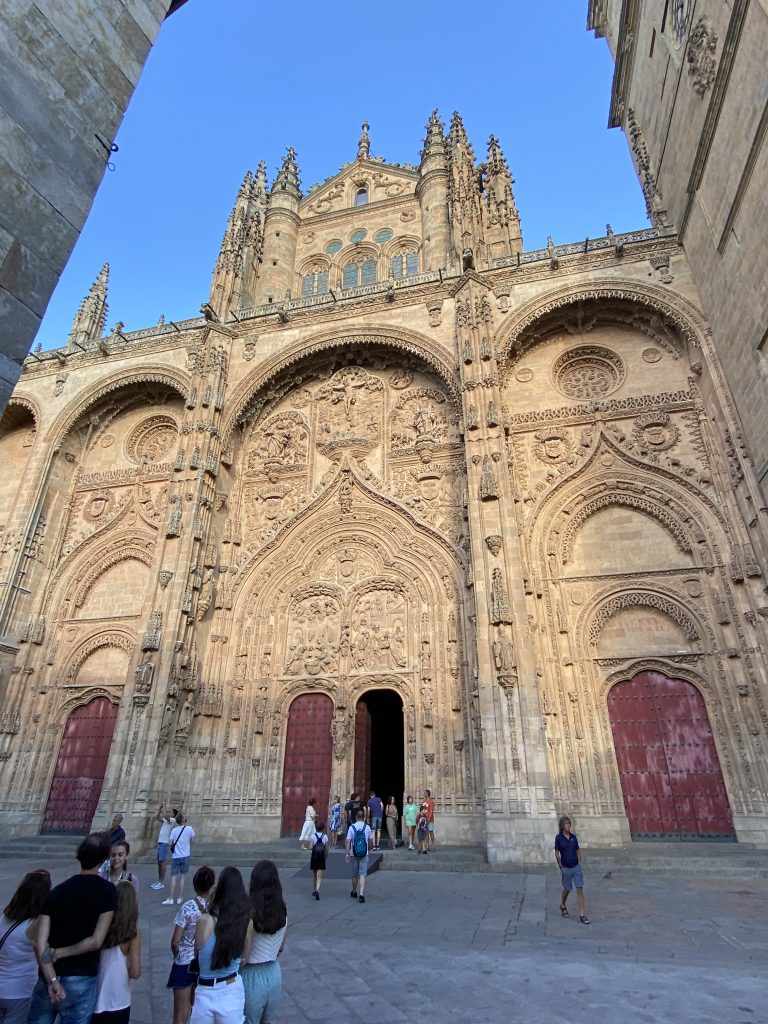


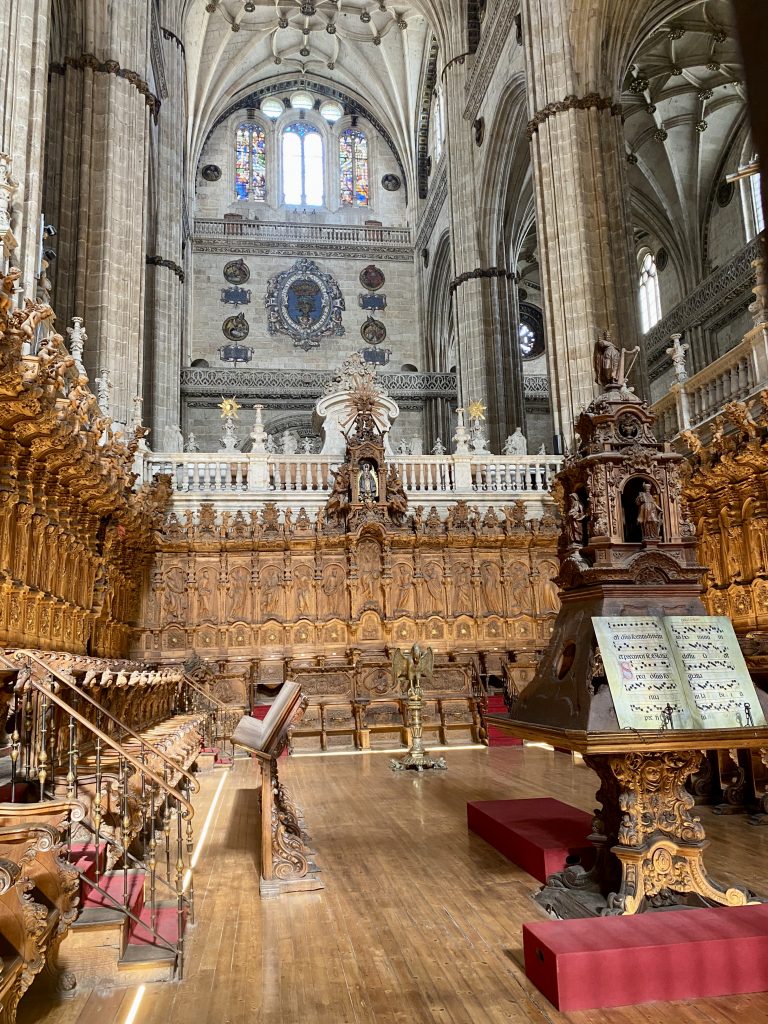
Except on special occassions, access to the Old Cathedral is through the New Cathedral. Dedicated to Santa Maria de la Sede, the Old Cathedral is considered less grand than the New Cathedral but for me, for various reasons, it is equally impressive. The star of the show in the Old Cathedral is the beautiful 15th century altarpiece with 53 painted panels but I also liked the relative simplicity of Capilla de San Martin (St Martin’s Chapel) with it’s 12th century painted walls and I especially liked the cloisters and the Capilla de Santa Barbara.
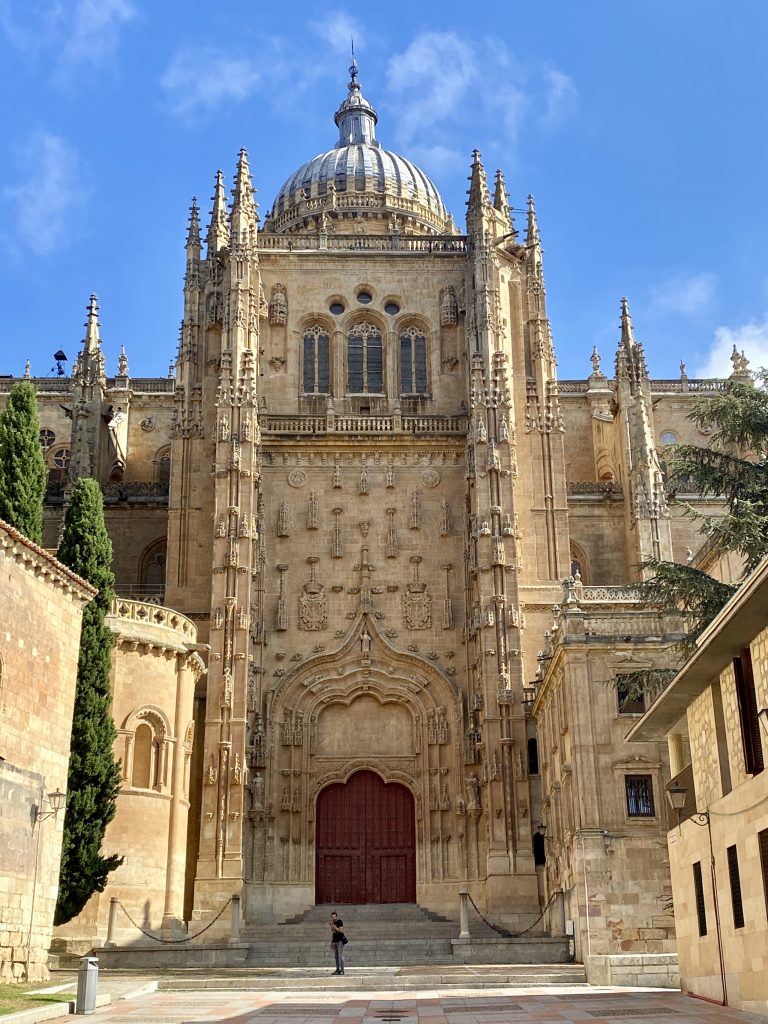
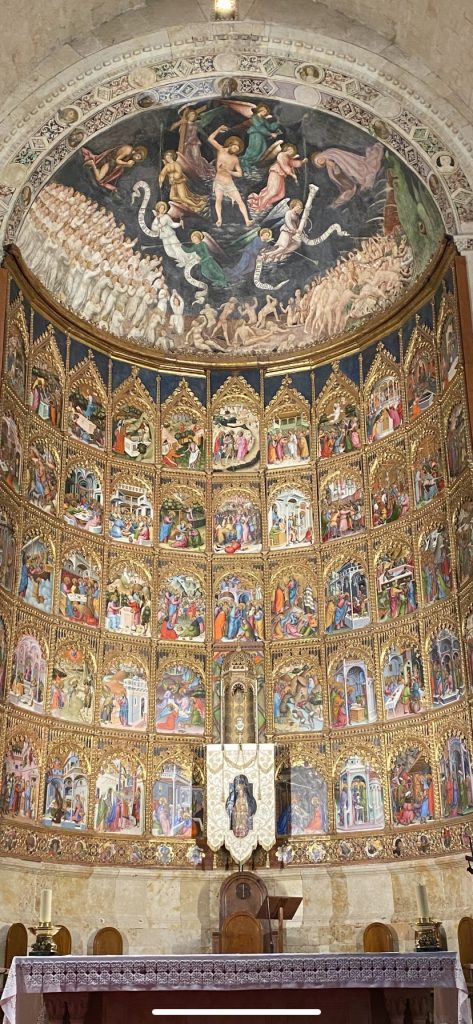
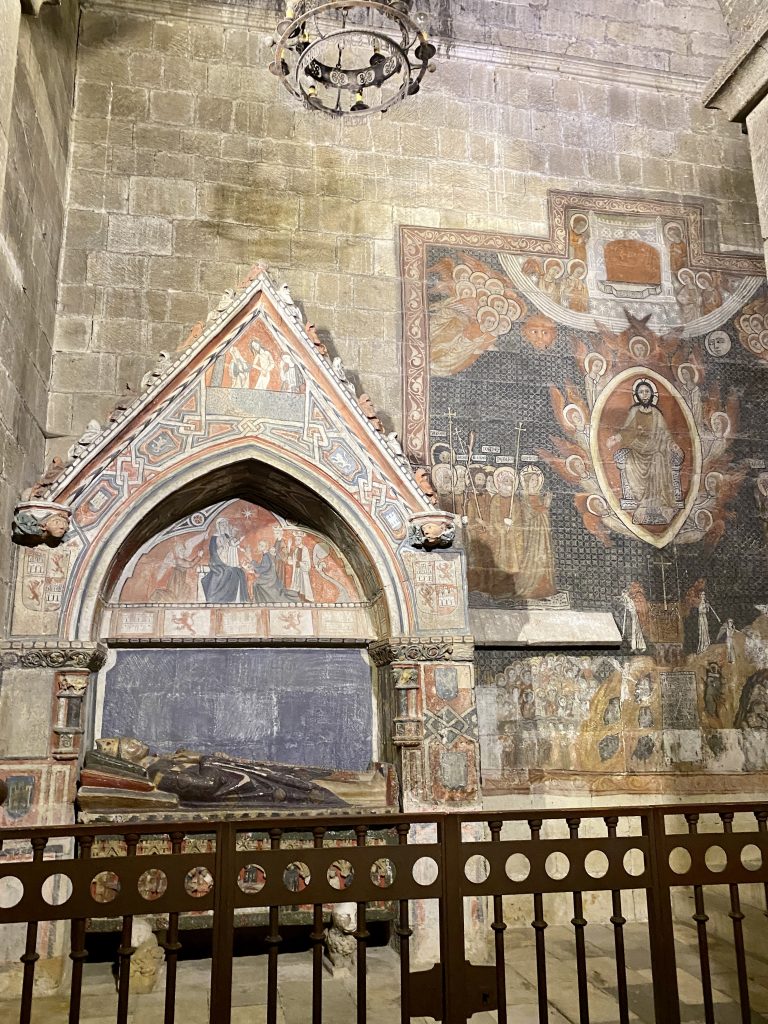
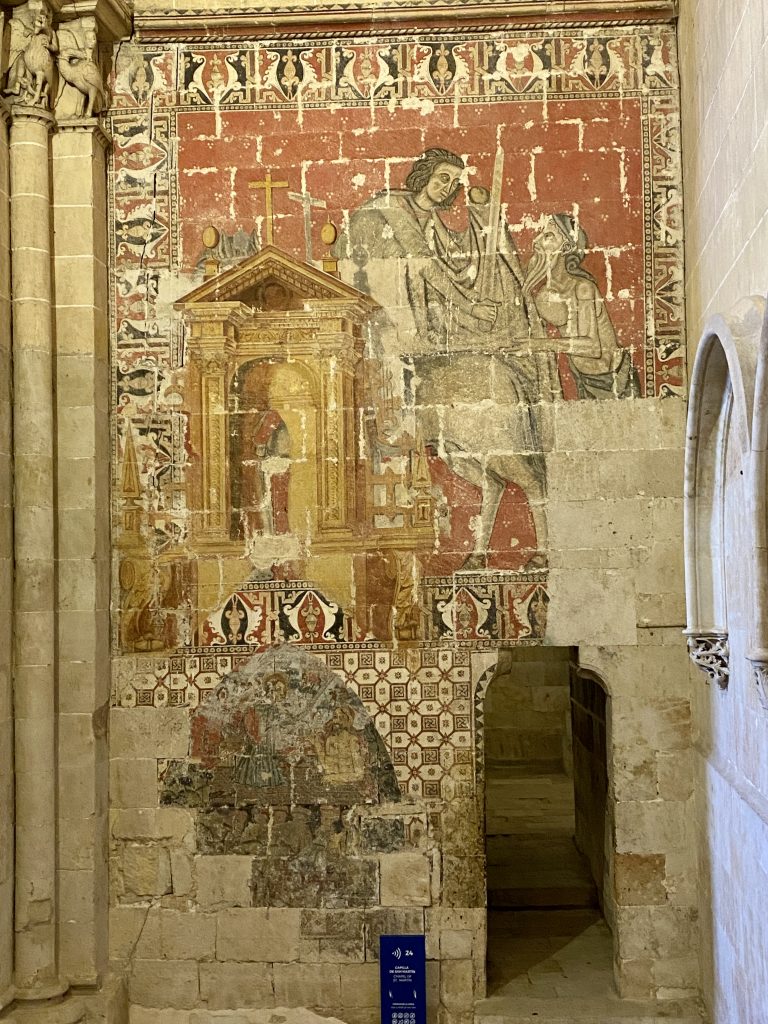
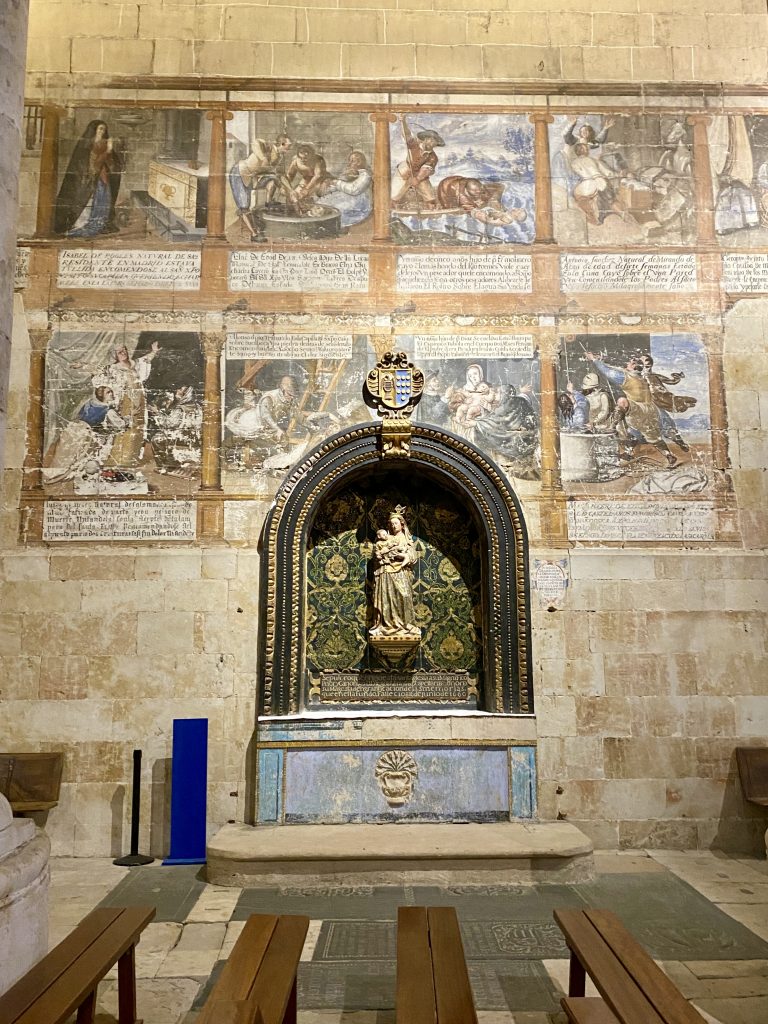
Unfortunately I missed out on what is known as the Ieronimus Tour. Climbing the Ieronimus Tower provides access to the higher levels of the cathedrals (i.e. to the upper levels inside the New Cathedral and up on to some external terraces and towers where you can walk among the pinnacles, gargoyles, etc) and offers birds eye views both inside the cathedral and across the city. I’d return to Salamanca for this tour alone. Access is from the southwest tower of the Old Cathedral on Plaza Juan XXIII.
Having missed out on the Ieronimus Tour I went instead up into the bell towers of ‘La Clerecia’, sometimes called the Scala Coeli (Latin for Stairway to Heaven), for it’s views. This prominent early 17th century church, once called the Royal College of the Company of Jesus, is now the headquarters of the Salamanca Pontificia University. It sits alongside another celebrated Salamanca building, the Casa de las Conchas (House of Shells), a 16th century Gothic Palace which is now the City Library. The Casa de las Conchas is so named because it’s facade is adorned with 300+ stone carvings of scallop shells. Both buildings are well worth a visit; La Clerica for it’s views towards the cathedrals and across the city’s roof tops and La Casa de las Conchas for it’s amazing inner courtyard.
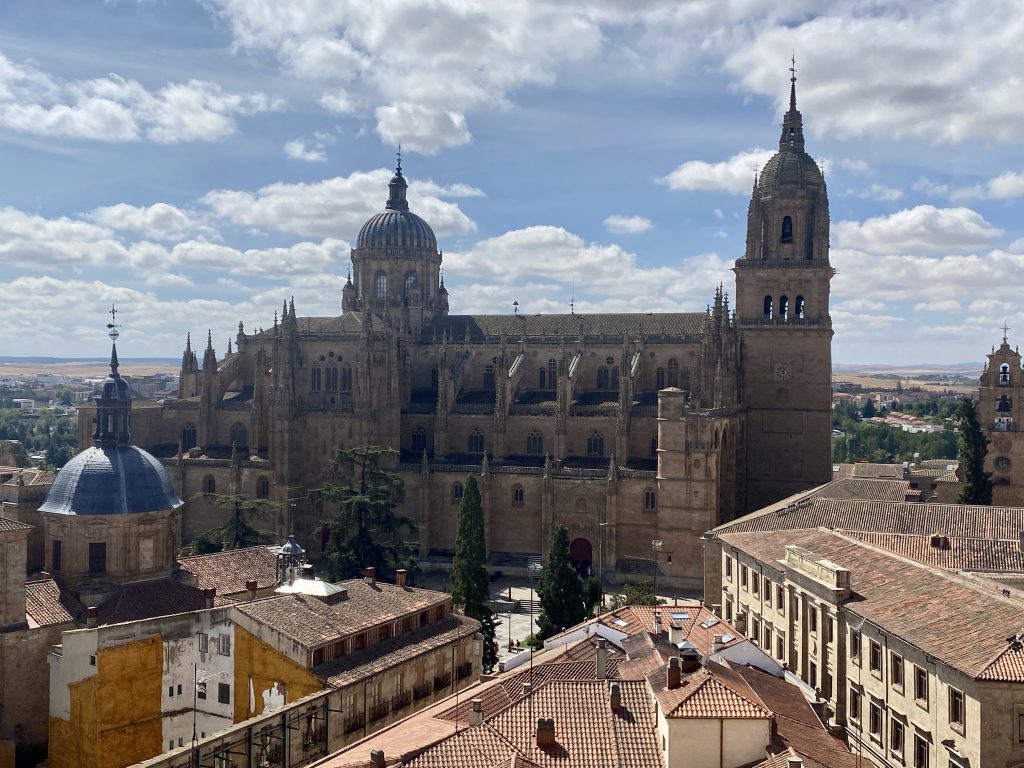
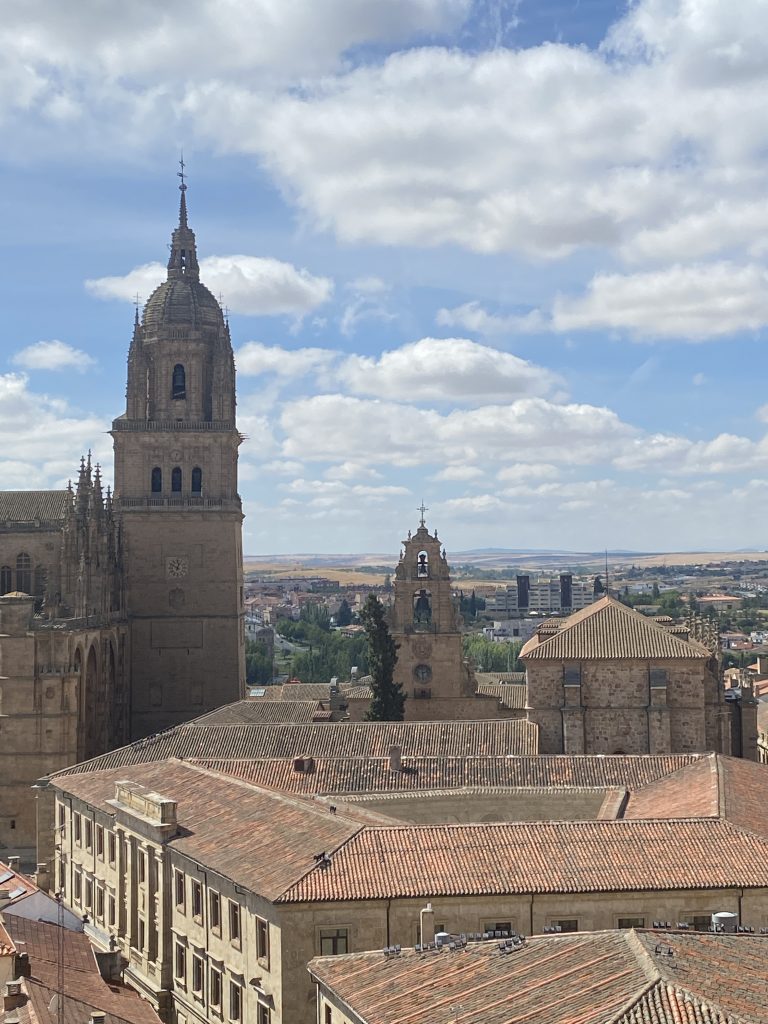

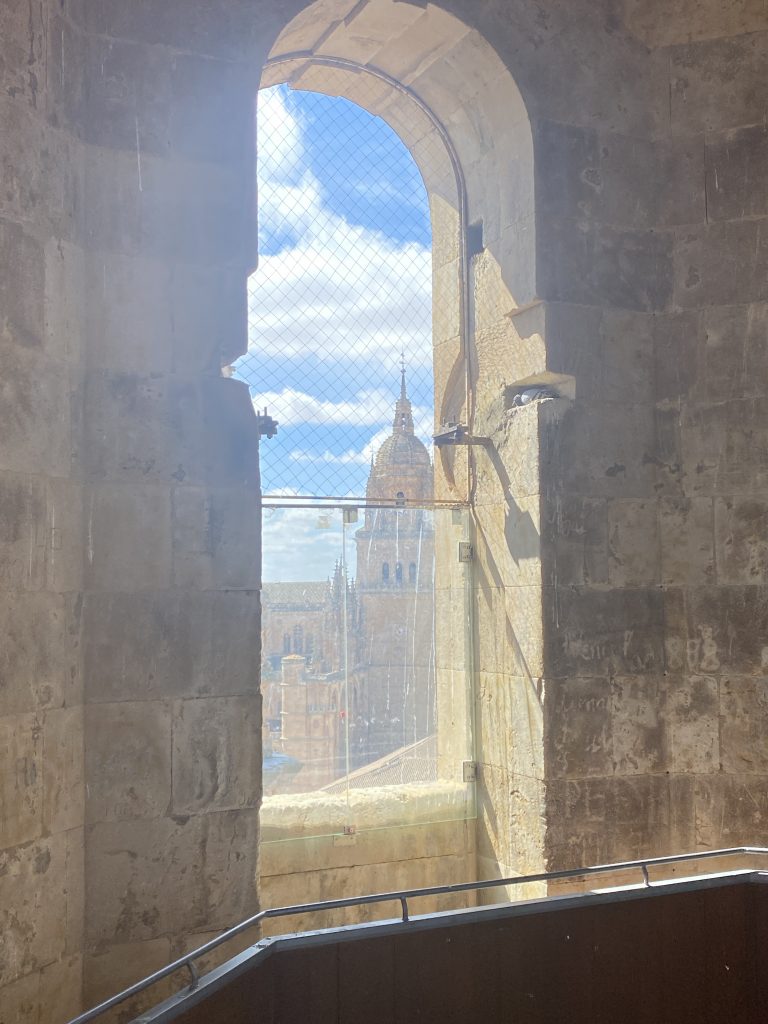
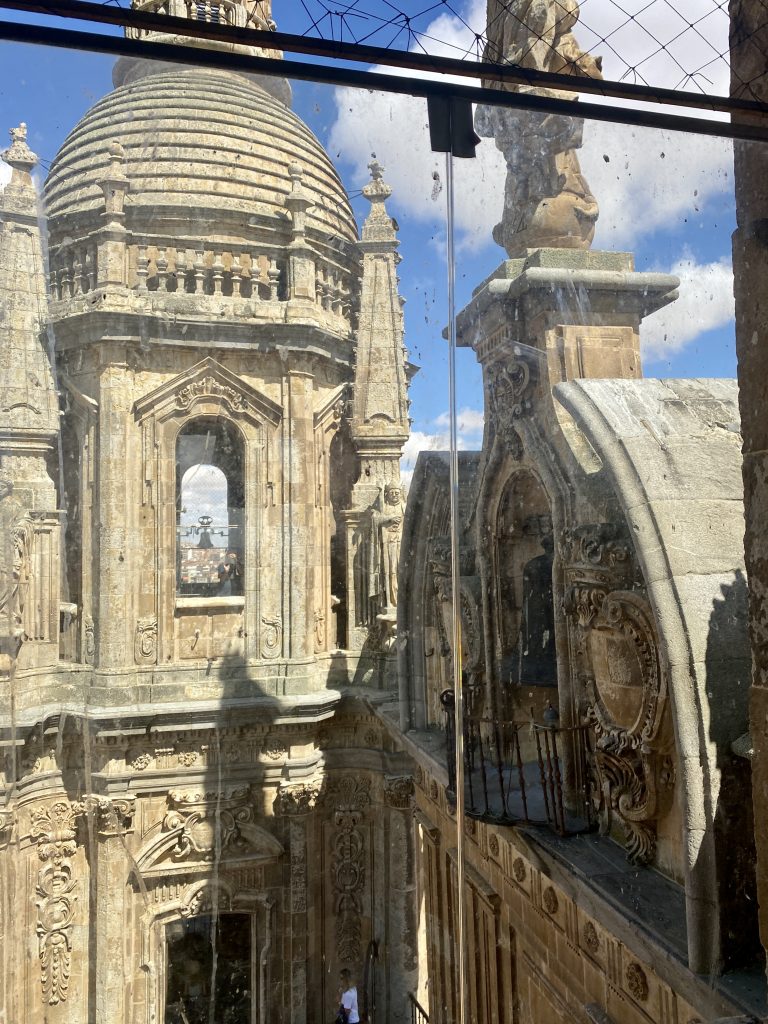
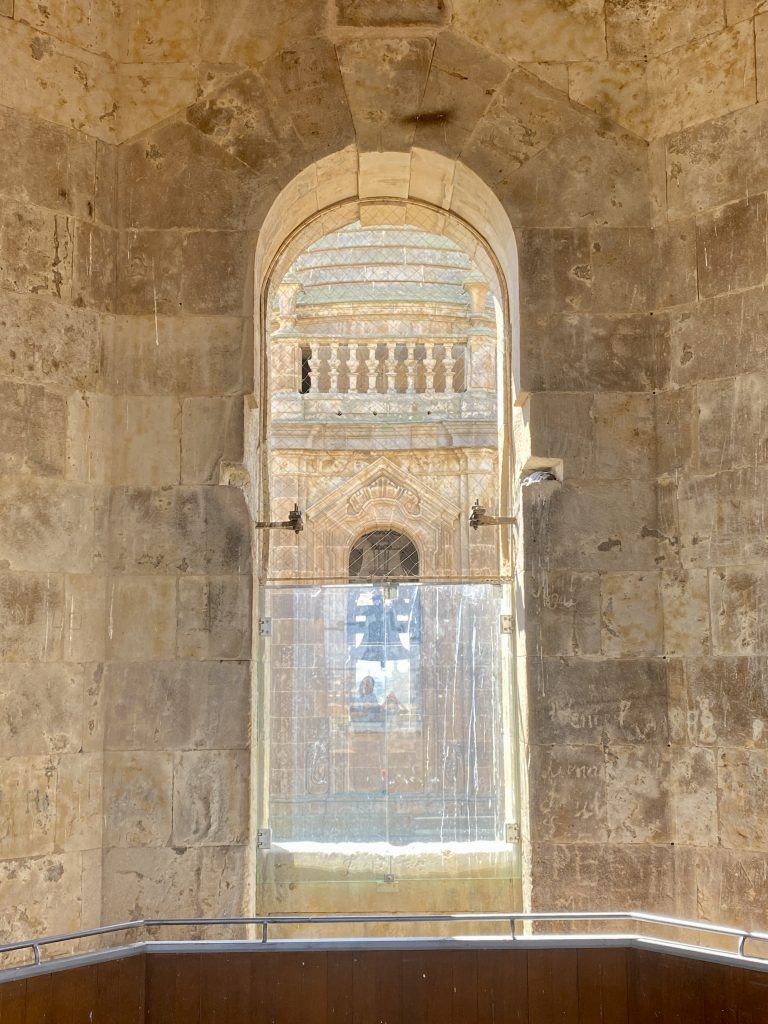
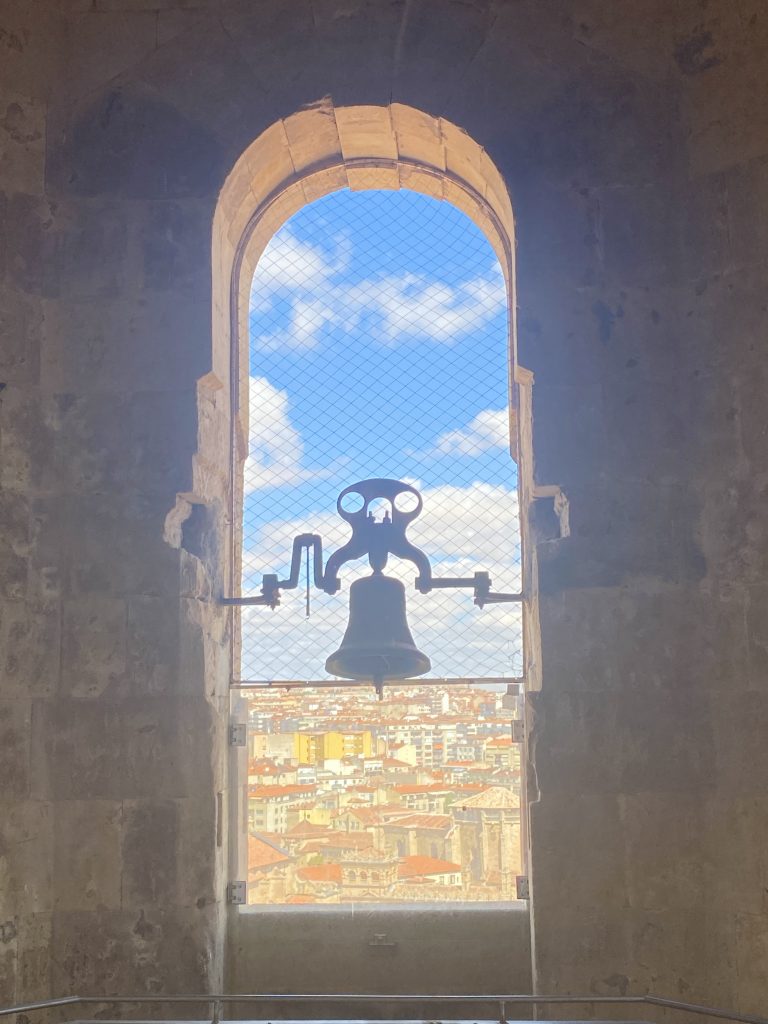
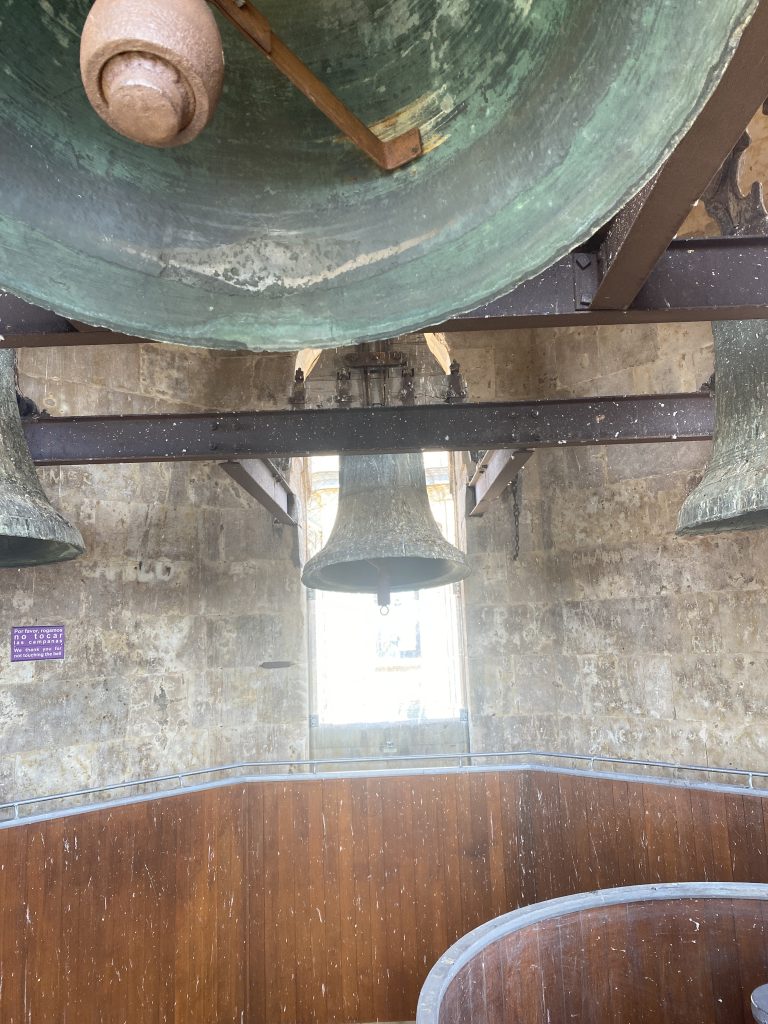
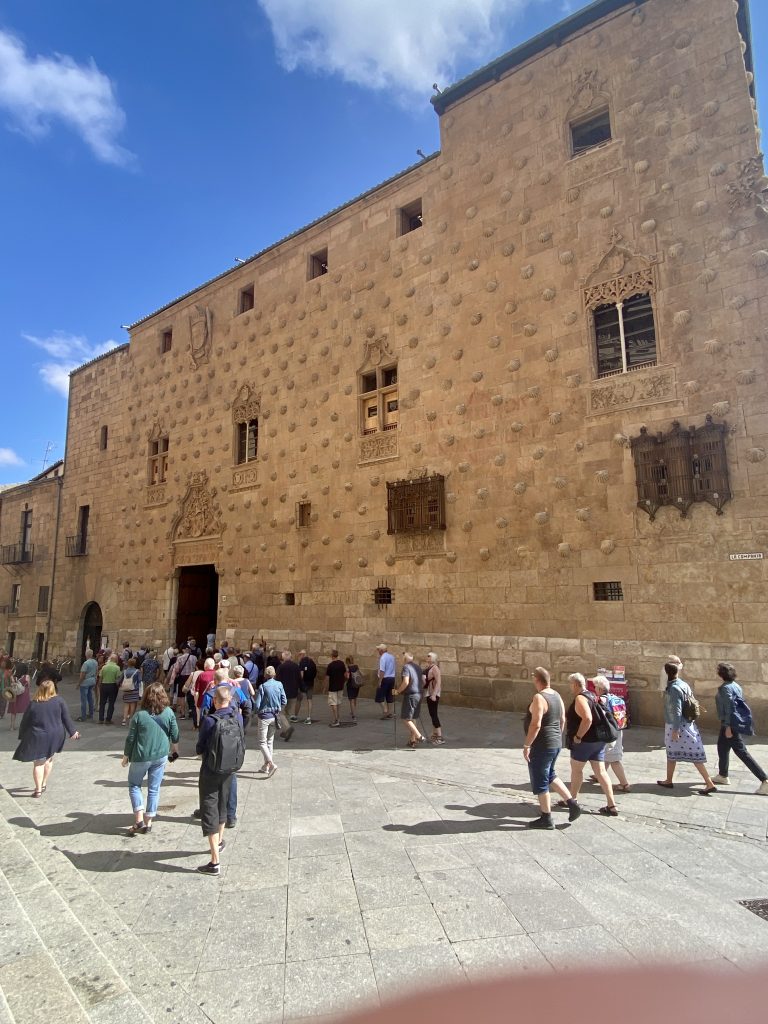
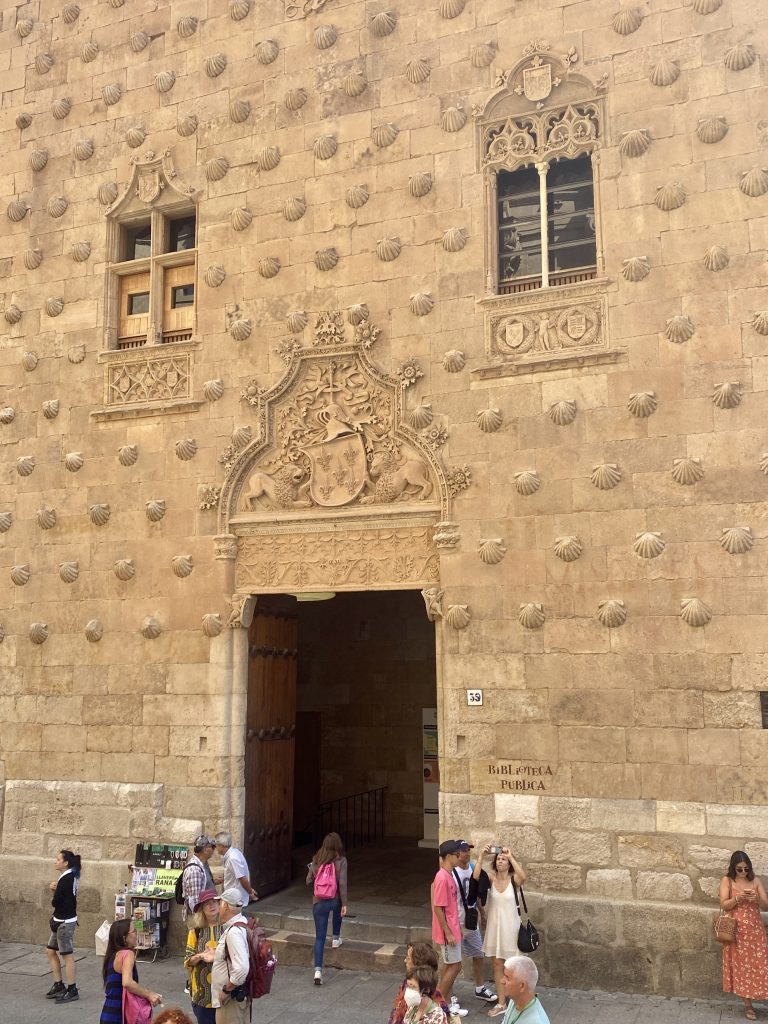
Given that Salamanca has long been recognised as a major seat of learning (particularly between the 13th and 16th centuries) and it’s campus fills the greater part of the old town, I should mention the University of Salamanca. It was founded in 1134 and is the oldest university in Spain and the 3rd oldest in Europe after Bologna and then Oxford. Some books identify Salamanca as being the 4th oldest university in Europe but it is the 3rd oldest surviving university.
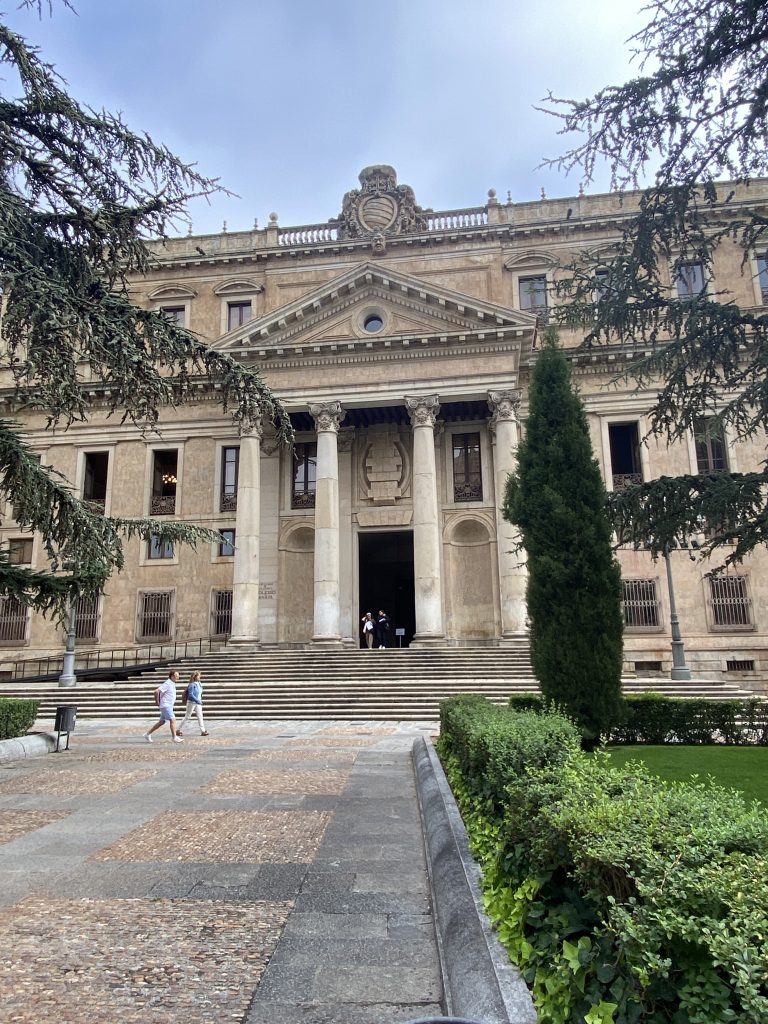
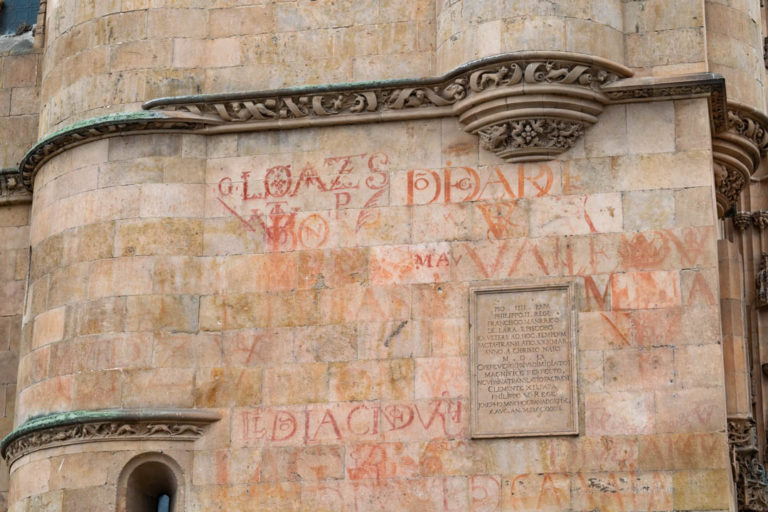
It’s time to talk about food, the good and the not so good. First the not so good. While checking out the cathedrals I stopped for a beer and was given free pinchos. It wasn’t that nice. I subsequently discovered it was pig’s snout. Ugh!
On a brighter note, we had reserved a table in the very popular campsite restaurant and their food and wine (Albarino) proved very good. Their cheese board included a soft blue cheese (Musgo de Cabra) which was outstanding.
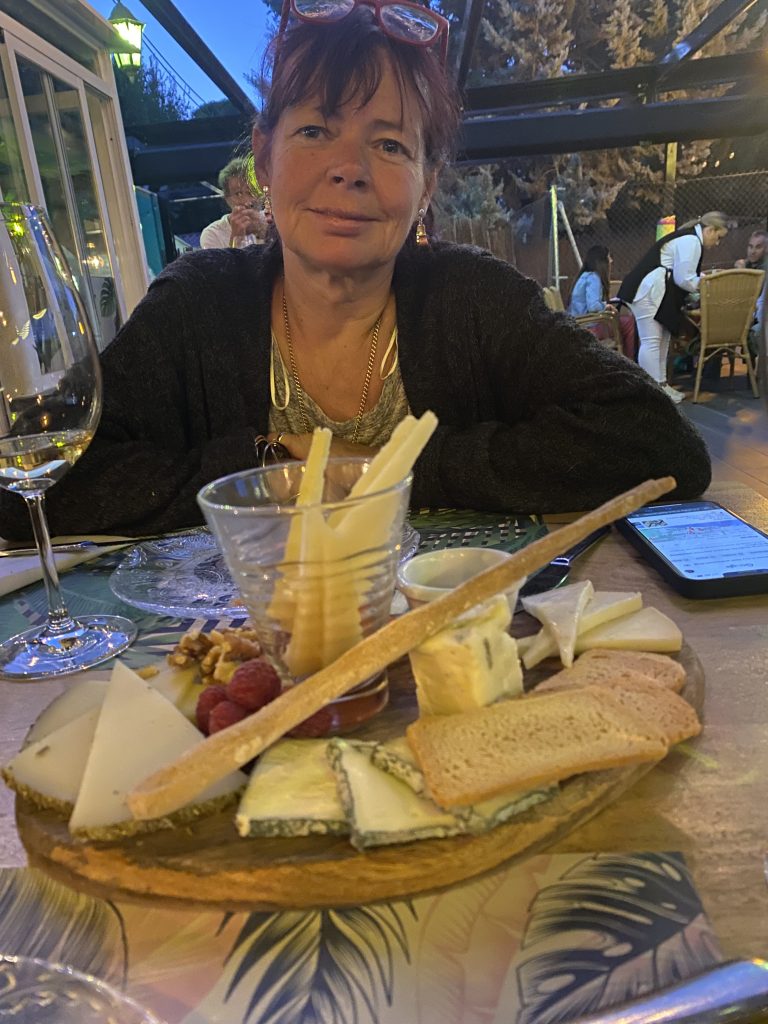

Our stay in Salamanca was all too brief. I could easily spend 3 or 4 days in the old town alone but there is also much to see outside the city. Leaving aside the pretty and interesting towns of Segovia and Avila (especially the UNESCO World Heritage Site of Avila) there is the wine producing area around Valladolid and the dazzling nature park of Arribes del Duero. This place begs at least a long weekend in a hotel.

